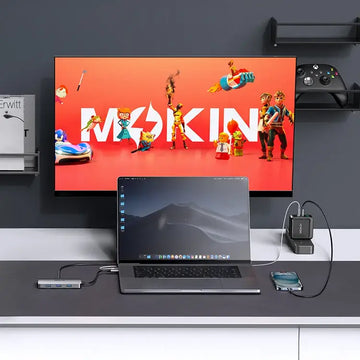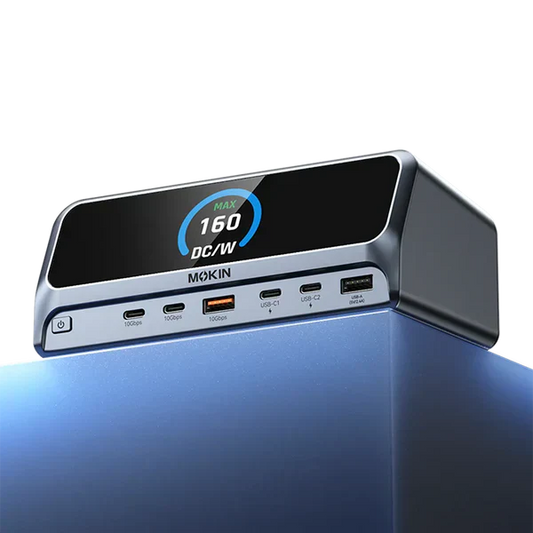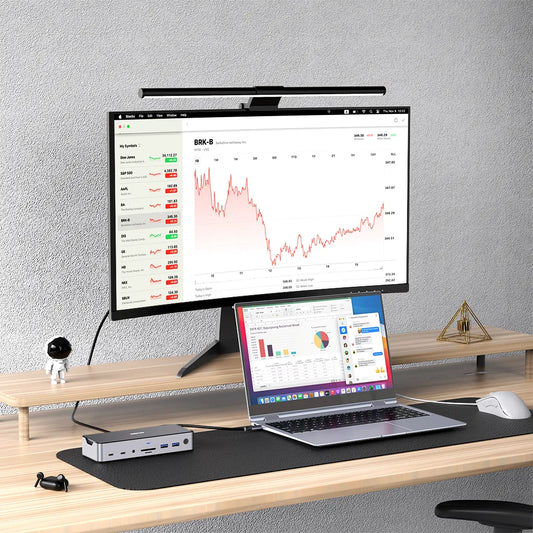Differences Between Hubs and Docking Stations in 2025
Contents
Hub
——————————
A USB hub is a tool that extends a USB-C port into multiple ports, providing more choices for connecting devices. Connected through a USB-C hub, all devices share the available bandwidth distributed by that hub.
Most laptops have built-in USB ports. However, an external USB hub can connect many common devices. This includes a mouse, keyboard, or external hard drive. Using a hub makes it easier to connect and disconnect multiple devices at once.
These hubs may include individual power switches for every port so that they can achieve easy power cycling of unresponsive devices.

Docking Station
—————————————
A docking station makes it easier to charge a smartphone or connect common accessories to a laptop by plugging in a mobile device. Certain laptop computers can act as desktop replacements with the help of a dock. Docking stations typically have a number of ports that you can use to extend the connectivity to your device.
Docking stations are frequently utilized in offices when employees need to switch between different screens without constantly connecting and unplugging different cables.

Capabilities and Features
————————————————————
The main difference between a USB hub and a docking station is their function. As port adapters, USB-C hubs are used primarily to enhance USB connectivity but have a limited number of ports. This setup is ideal for connecting basic peripherals such as keyboards, mice and printers. The interface standard of the host device may limit data transfer speeds.
MOKiN 6 IN 1 USB C Hub unleashes the full potential of your laptop's USB-C port with 4K HDMI, two 5Gbps USB A ports, 480Mbps USB A ports, and an SD/Micro SD card reader. It expands the functionality of your workstation.
The USB C Hub provides transfer speeds up to 5Gbps with dual USB A 3.0 data ports. It's the perfect hub for travelers with USB-A accessories, like an external hard drive, keyboard, and mouse.
Meanwhile, the adapter comes with an HDMI, delivering 4K@30Hz or full HD 1080P video. It acts as a cable dongle to use USB-A peripherals with a device that only has USB-C ports. The SD & Micro SD card reader is for USB-C or Thunderbolt 3 devices to access files.

Take an example, the MOKiN 8 IN 1 Docking Station Dual 4k@60Hz HDMI has two HDMI ports, an Ethernet port, three USB-A data ports, a USB-C data port, and a USB-C Power Delivery input. With USB-C and USB-A connections that can transport data at up to 10Gbps and HDMI that can display 4K@60Hz videos, this hub also boasts fast speed.
The design is ideal for combining work and play needs into a single USB-C dongle. Its compact size also makes it simple to carry around.

Power Supply
——————————
Regarding the charging process, USB-C hubs obtain power from your device and subsequently supply power to the attached peripherals. Certain hubs feature a USB-C Power Delivery input port, enabling users to link their laptop's charger to this port and then connect to a wall outlet. This configuration allows you to charge your laptop through a method known as pass-through charging.
On the other hand, docking stations are more powerful. There are two types of docks. Portable docking stations derive power from your laptop, while fixed ones need to be connected to a wall outlet using an AC/DC power adapter.
The benefit of fixed docking stations is their ability to charge your laptop rapidly. Some docking stations may support faster charging speeds and offer power management and optimization.

Application
——————————
In terms of video extension, a USB hub generally supports only one external display at lower resolutions. Thus, it's suitable for basic tasks instead of complicated setups. Docks are able to handle multiple monitors with high resolutions.
Hubs are suitable for users who need to expand their connection while on the move. Docks are intended for designers, programmers, and video editors.
Compatibility
————————————
As for compatibility, USB hubs and docking stations have distinct characteristics. USB hubs usually have a plug-and-play function, facilitating effortless connectivity without additional software or drivers. This feature allows them to work with many devices, from laptops to gaming consoles, and with different operating systems.
Docking stations need specific drivers or software installations for optimal operation, tailored to be compatible with particular laptop models or device brands. These drivers or software are often essential for ensuring the docking station functions at its best.
Portability
—————————
USB hubs are small in size, making them fit for portable use. Their compact body enables easy carrying in a bag, facilitating the expansion of USB ports on the go.
On the other hand, docking stations are larger and intended for fixed installations in office settings. Their larger size is indicative of their capacity to bring more connections and extra power.
With limited ports and a relatively fixed design, hubs are often used for travel. Docks typically offer greater customization options, enabling users to choose a dock with specific ports and features that suit their workflow and needs.
Cost
—————————
Price plays a crucial role in deciding between a USB hub and a docking station. USB hubs are generally more affordable, making them an excellent option for users seeking to enhance their connectivity without a substantial budget.
Docking stations are more expensive because they offer enhanced advantages, including expanding multiple displays, transmitting data quickly, and accommodating more peripheral settings. However, docking stations provide long-term value for users with multiple devices, making them particularly suitable for professionals and businesses.
Conclusion
—————————
As laptops evolve, USB-C hubs and docking stations progress as well. As the Thunderbolt 4 standard emerges as the preferred choice, enhanced adapters are expected to be more optimal in the future. With each new MacBook or Windows laptop model launch, there is a corresponding USB-C hub or docking station to be used as a matching accessory.
Purchase a USB hub or a docking station. It relies on your requirements and they way you use the device. If you seek an easy way to increase several USB ports while traveling, a USB hub could be the ideal choice. Portable and suitable for mobile usage, it offers convenience for travelers.
If you work at a desk all the time and need additional power to charge your laptop in addition to connecting more devices, including a monitor, then buying a docking station is a smart choice. It has more available ports, can handle complex setups, and also has typical features such as support for HD video.
No matter which one you pick, you will enhance the functionality of your devices and significantly reduce the time spent hunting for dongles or adapters. Are you prepared to optimize your workspace with the perfect solution? Whether you aim to broaden connectivity with a USB hub or revolutionize your workstation with a docking station, MOKiN has a tailored solution for you.
YOU MAY ALSO LIKE
——————————————

MOKiN 13-IN-1 USB-C Laptop Charging Station with 2.26-inch LCD Smart Display











